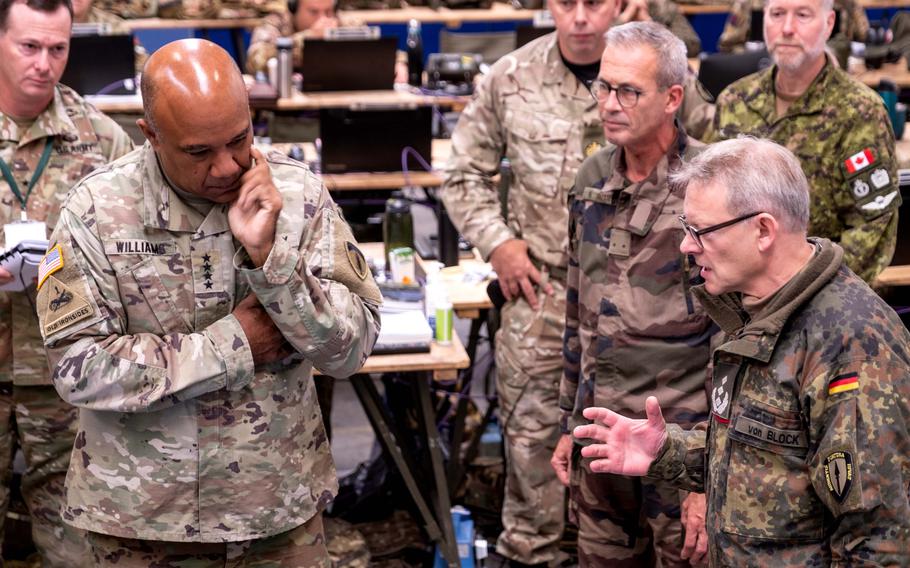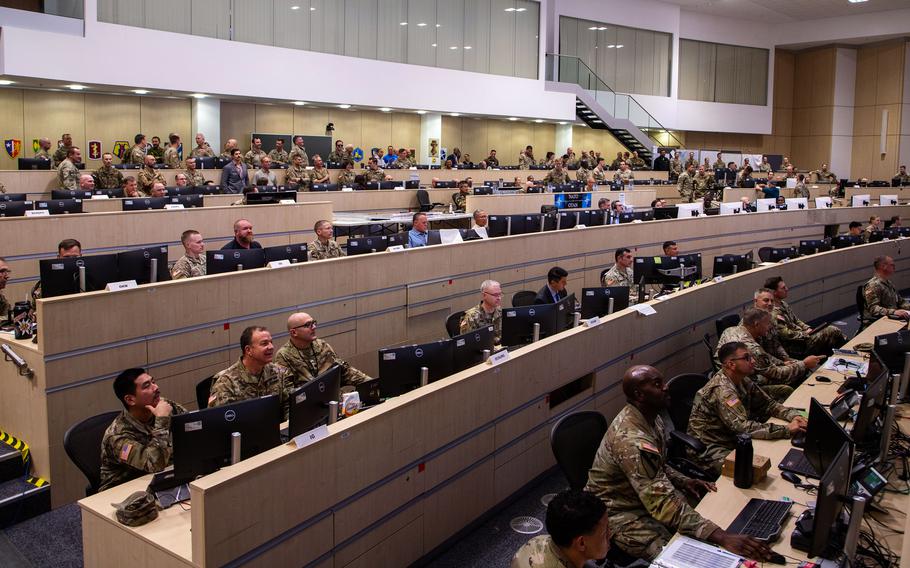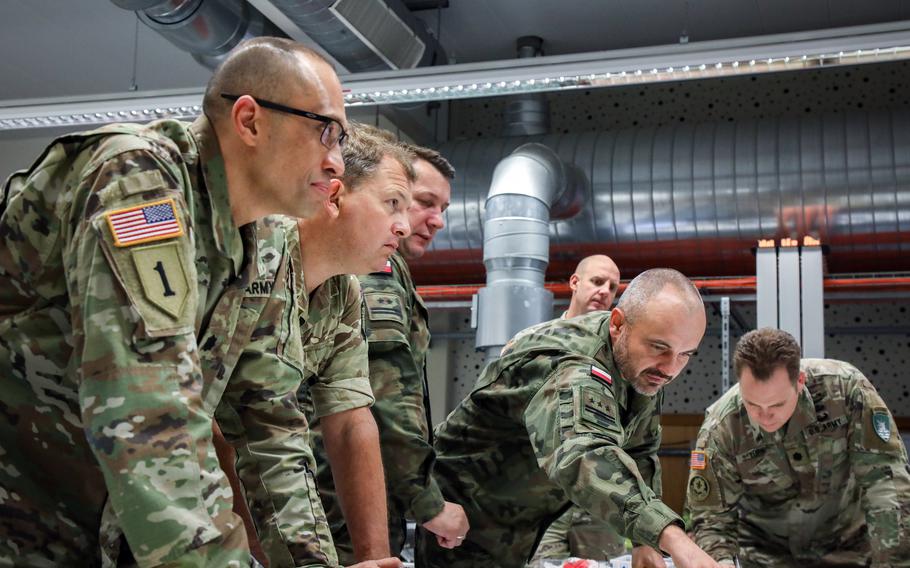
German Col. Michael Von Block, front right, briefs Gen. Darryl A. Williams, U.S. Army Europe and Africa commander, during Exercise Avenger Triad 24 in the United Kingdom on Sept. 15, 2024. (Kyle Larsen/U.S. Army)
WIESBADEN, Germany — With maps and graphics flashing on movie theater-sized screens, top U.S. Army commanders monitored in real time a scenario of all-out ground war with Russia as new NATO defense plans were put into operation for the first time.
U.S. Army Europe and Africa was at the center of the action for Avenger Triad 24, a two-week drill that wrapped up Thursday. It involved 10 other countries and multiple alliance regional corps that oversee alliance front-line troops.
“I’ve been in and out of this European theater for 41 years, and I will tell you, I’ve never seen this sort of implementation,” Gen. Darryl Williams, commander of U.S. Army Europe and Africa, said this week at his Wiesbaden headquarters. “That’s what this exercise is about.”
U.S. Army Europe and Africa served as the middleman between a higher Allied Joint Forces Command Brunssum headquarters in the Netherlands and lower-level allied corps that controlled the movements of some 180,000 troops fanned out across Europe.
Huddled on one side of the command center, soldiers known as the “lethal triad” handled air and missile defense, intelligence and aviation matters. Williams and his senior deputies, who were tasked with preparing NATO ground troops, occupied the middle of the combat command post.
Russia’s 2022 invasion of Ukraine has prompted the U.S.-led NATO alliance to take steps to bolster defenses that were almost unimaginable a little over a decade ago, when many viewed the American presence in Europe as a Cold War relic.
While the smaller Russian invasion of Ukraine in 2014 brought Pentagon attention back to the Continent, the ongoing war throughout Ukraine that began Feb. 24, 2022, has taken matters to another level.

U.S. Army and NATO personnel are briefed at Clay Kaserne in Wiesbaden, Germany, on Sept. 19, 2024, as part of exercise Avenger Triad 24. (Victor Leonard/U.S. Army)
The U.S. Army in Europe and its allies are now working through command-and-control challenges that had not confronted them since the days of mass mobilization drills prompted by the Soviet threat.
“Obviously, the game changer has been the (2022) invasion of Ukraine,” said Spanish Lt. Gen. Luis Lanchares, deputy commander of Allied Joint Forces Command Brunssum. “Since that moment, NATO, fully supported by the nations, has totally accelerated what we were doing before the invasion.”
USAREUR-AF quickly saw the need to rapidly secure its headquarters. Then-commander Gen. Christopher Cavoli, who now serves as NATO’s supreme allied commander, directed his team in Wiesbaden to build a secret command post should events escalate, making his headquarters a target.
Though still available, that command site didn’t factor into Avenger Triad 24, said a U.S. defense official, who noted that the war game scenario called for the Army’s Wiesbaden compound to be well-defended.
But the exercise dug deep into a new combat playbook approved during NATO’s Washington summit in July that lays out in granular detail how units would respond to an invasion.
The Russia-Ukraine war also factored into the planning, with an emphasis on being able to shield command and control sites from targeting or put them on the move to evade detection, Williams said.
Military officials declined to detail specific territorial areas of focus for security reasons. However, the scenarios dealt with how ground forces would defend the whole of the alliance, officials said.
The commanders had to grapple with not only large-scale combat operations but also the ripple effects: thousands of displaced civilians, prisoners of war, high casualty numbers and resupply of troops in far-flung places, military officials said.

Members of the "white cell" leading Avenger Triad 24 hold a coordination meeting at the Joint Multinational Simulation Center in Grafenwoehr, Germany, on Sept. 17, 2024. (Thomas Dixon/U.S. Army)
“The thing we need to really get out of exercise like this is the human element,” said Group Captain Michael Dutton, a Royal Air Force officer who serves as head of operational planning at Brunssum. “It’s learning to work together.”
The key to bringing it all together rests on allied commanders being able see eye to eye, anticipating how their counterpart thinks in a fast-moving battle, he said.
Dutton likened Avenger Triad 24 to how a football team builds chemistry through practice. A quarterback, receivers and offensive line can be great individually but fail on the field without putting in the “sets and reps,” he said.
“What’s really difficult is anticipating what your (allied counterpart) is going to do, understanding how they think,” Dutton said. “Because as soon as we get into contact with the enemy, you know the plan is going to have to adapt based on what we see.”
Dutton described their chemistry now as being in early season form and working toward playoff readiness.
Williams said initial takeaways center on stamping out the chances for miscommunication between headquarters and multinational corps that command troops in the field.
“We are doing things like corps passage of lines, which we haven’t done in a long time,” Williams said.
Passage of lines, or the movement of large units past each other on the battlefield, creates the potential for mishaps if there is operational confusion and mixed messages, Williams said.
The expectation on USAREUR-AF is that it can synchronize higher command objectives down to the corps and tactical units on the front lines.
“The corps will fight this at the leading edge of the battlefield,” Williams said.
When it comes to resupply, allies are looking for any gaps in their planning assumptions and gaps in the logistical chain, said Col. William Laase, a top USAREUR-AF deputy.
“Knowing where our supplies are and how available they are at the point where we transition from competition to crisis is important,” he said. “And we’re learning that maybe we’re out of position in some of our aspects.”
Avenger Triad 24 operations were centered at Wiesbaden but stretched over large swaths of NATO territory. They involved numerous Army units in Germany and incorporated forces along NATO’s eastern flank and beyond.
Besides informing what the exercise participants did, the Russia-Ukraine war has reinforced the need to convey the magnitude of such large-scale fighting beyond the level of the combatants, Williams said.
“It’s going to cost a lot if we had to do this, in terms of our ability to prosecute it and informing our civilian masters about ... the human cost,” he said. “It’s going to require steely-eyed resolve.”